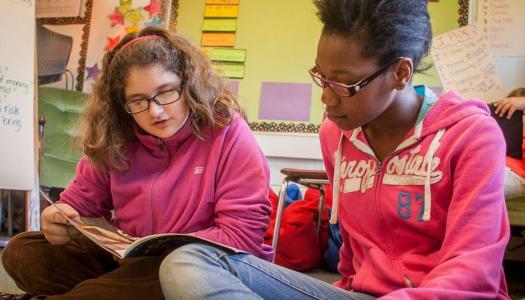The Ripple Effect: Spreading Professional Learning
Join Our Community
Access this resource now. Get up to three resources every month for free.
Choose from thousands of articles, lessons, guides, videos, and printables.
by Sara Hankins
 I like to compare professional learning to spending a day at the swimming pool. Not because of flip-flops or the smell of sunscreen, but because of the variety of ways in which we choose to engage in the experience. At the pool are folks who are content to sunbathe on the deck, others who just dip their toes into the water, and those who without any hesitation do cannonballs off the diving board. Similarly, some folks participating in professional learning experiences are content to hear it, others are open to trying some of it, and others dive into the learning completely. The splash and waves from the “all-in” crowd might touch everyone in and around the pool. There is a ripple effect.
I like to compare professional learning to spending a day at the swimming pool. Not because of flip-flops or the smell of sunscreen, but because of the variety of ways in which we choose to engage in the experience. At the pool are folks who are content to sunbathe on the deck, others who just dip their toes into the water, and those who without any hesitation do cannonballs off the diving board. Similarly, some folks participating in professional learning experiences are content to hear it, others are open to trying some of it, and others dive into the learning completely. The splash and waves from the “all-in” crowd might touch everyone in and around the pool. There is a ripple effect.
Merriam-Webster’s Unabridged online dictionary says a ripple effect is a spreading, typically unintentional effect (2017). Educators can create a ripple effect that positively influences student learning within teams, schools, districts, and beyond. However, in a departure from the definition, educators can do it with great intention. If you don’t have a schoolwide initiative to implement The Daily 5, CAFE, or Math Daily 3, and are faced with a hesitant or even resistant team, here are some suggestions to help create a ripple effect.
Adult Learners’ Needs
When sharing professional learning with colleagues, it is important to think about what adult learners need to feel productive and energized. Elena Aguilar, an instructional coach, teacher, and author, points out that there is real science behind what adult learners need. She notes that specific criteria must exist for professional development to be meaningful, some of which are a positive feeling about the learning, noticeable application of the learning, and concrete experiences in which to apply the learning (Aguilar, 2011). Find ways to help the team get excited, invested, and curious about the new learning so that the learning will become pervasive.
Goal Setting
Another strategy that proves to be successful in a collaborative learning experience is goal setting. Both kids and adults have a desire to know why we’re doing something (Boushey & Moser, 2014), so setting a purpose and creating a sense of urgency is equally important to professional learning. It is helpful to write specific goal statements using a frame like this: “Our team will ____________ , to ____________ , so that ____________.” Ask your team, “Why do we want to learn this? How will our learning affect students? And how will we know our professional learning is successful?” A team goal statement might sound something like this: “Our team will enroll in the Math Daily 3 online seminar to learn about a structure that promotes independence and meaningful learning experiences [Boushey & Moser, 2014] so that students will be engaged in math.” Goal-setting practices are important to any professional learning, especially if the learning is intended to spread to others.
Collaborative Assessment of Learning
Professional learning might include reading texts, writing lesson plans, implementing structures such as The Daily 5 and Math Daily 3, discussing content with colleagues, and comparing old structures with new ones. Throughout the professional learning experience, it is beneficial to collaboratively reflect on what is working, the challenges or opportunities for growth, and next steps (Behne, n.d.). It is also helpful to use a collaborative assessment log. The log is an organized and balanced way to take “snapshots” of professional learning. If the deep dive into research-based curriculum, instruction, and assessment is going to have a ripple effect on our teammates, colleagues, and beyond, then collaboratively reflecting throughout the learning is critical (Sabo, 2013).
Take the Plunge
Just like the epic cannonball off the diving board, the success of The Daily 5, CAFE, and Math Daily 3 is contagious (Behne, n.d.). It inspires, sparks curiosity, and forces us to stop and think. Take a deep breath, go all out, and make waves!
References
Aguilar, E. (2011). The science behind adult learning. Edutopia. Retrieved from
https://www.edutopia.org/blog/adult-learning-pd-elena-aguilar
Behne, A. (n.d.). Leadership support—the gift of time! Part 2 of 3. The Daily CAFE. Retrieved from
/articles/leadership-supportthe-gift-of-time-part-2-of-3
Behne, Allison (n.d.). Leadership support—know what to look for. Part 3 of 3. The Daily CAFE. Retrieved from
/articles/leadership-supportknow-what-to-look-for-part-3-of-3
Boushey, G., & Moser, J. (2014). The daily 5. Portland, ME: Stenhouse / Markham, ON, Canada: Pembroke.
New Teacher Center at University of California, Santa Cruz. Collaborative assessment log. Retrieved from http://blogs.henrico.k12.va.us/mentorprogram/files/2009/06/collaborative_log.doc
Ripple effect [Def. 1]. (n.d.). In Merriam-Webster Unabridged online. Retrieved April 25, 2017, from http://www.merriam-webster.com/dictionary/rippleeffect
Sabo, L. (2013). Collaboration. The Daily CAFE. Retrieved from /articles/collaboration







